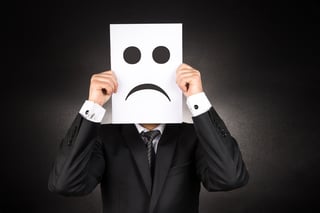Growth Insights for CEOs

Outsider Insights | From Hustle to System: Why More CEOs Are Rebuilding Their Sales Function
Outsider Insights
Across Chief Outsiders, we talk to hundreds of CEOs every month. In this new series, we explore the trends and challenges we’re hearing from these discussions – and what you can do if you’re facing the same issues in your business.
Recent Posts

Shift Your Brand Perception – Rally Others to Tell Your Story
Thu, Sep 27, 2018 — After reading my previous posts, you’re almost on your way to productively and energetically leveraging your brand’s perception to drive company growth and profitability. Our previous topics of focus covered the specific impact that brand perception can have on the bottom line and the need for clear positioning as the foundation for communicating about your company. It’s now time to examine effective ways to arm others with that refined market positioning. By understanding your story, employees, customers and other influencers will help you communicate this information to your marketplace. This strategy takes some of the pressure off your sales team. It also makes it easier to proliferate your vision, as well as the value of your product and service offerings. One of the biggest challenges small to mid-size companies face is promoting their company with limited resources. Not everyone has massive advertising budgets to flood the market, so you need to work smarter to get the most out of your marketing spend. One way to do that is to more effectively leverage your employee base and others who have influence in your industry. It’s much more powerful when others can tell the story for you.

Shift Your Brand Perception - Start with Getting Your Positioning Right
Thu, Sep 20, 2018 — In my previous post, we reviewed how brand perception specifically impacts company growth and profitability. Now we’ll cover the keys to building the foundation for communicating about your company. When companies start out, they usually have a very clear understanding of who their customer is, the problem they are solving, and possibly, how they are different. This is typically because they have a single product for a single market segment where they’ve achieved some level of success. But over time, as companies and markets evolve: The competition becomes more intense, either through matching capabilities, building new capabilities or new competitors appearing. Customer needs and priorities change. What was important to a customer 3 years ago may not be as important today. The company enters new market segments or geographies. There may be subtleties between industries, regions and countries in terms of priorities and pain points. The company broadens its portfolio of offerings. As more products are developed and more problems addressed, there might be new buyers and other selling dynamics.

Building a Long-Lasting Relationship Between Hispanic Consumers and Your Business
Tue, Sep 18, 2018 — When a business looks at how to approach the U.S. Hispanic consumer, it is quite easy for it to rely on commonly known facts: Family is important to them, their households are larger, and they over-index usage of mobile devices to gather information and shop online. Let’s not forget that they love soccer – and are deeply religious. However, to develop the most meaningful connection, it’s essential to dig a little deeper than the obvious. The same analytical rigor and behavioral curiosity we apply to our core US consumer (also known as the general population) needs to be involved in studying the Hispanic consumer and how they relate to your category. First, we’ll begin with an examination of the data, then uncover insights to understand what truly matters to this exquisite target.
Stay up-to-date with the latest from Chief Outsiders

CEOs, Are You Confident in Your Marketing Team’s Ability to Drive Growth?
Mon, Sep 17, 2018 — While most mid-sized companies have invested in dedicated, in-house marketing teams, many executives are not pleased with the return on investment. A survey conducted by The Fournaise Marketing Group revealed that 73 percent of CEOs believe their marketing team is not capable of generating enough growth. An astonishing 80 percent of the CEOs polled don’t trust their marketing teams. There is widespread concern that the marketing function is unable to deliver a positive ROI for the department’s spending. CEOs also doubt marketing’s ability to use data to make informed decisions. You may have some of the same concerns for your marketing organization. Much has changed in marketing over the last several years, but its core purpose has stayed the same. The American Marketing Association defines marketing as the “activity, set of institutions, and processes for creating, communicating, delivering, and exchanging offerings that have value for customers, clients, partners, and society at large.” Despite the challenges of an ambiguous and rapidly evolving business landscape, marketers must drive growth and prove their value to their company. This can be accomplished by focusing on marketing’s core responsibility: delivering value to customers and stakeholders.

“Wake Up Airplane!” – The Customer Journey Driving Delta
Fri, Sep 14, 2018 — At a major U.S. airport on a recent dark early morning, two major airline mechanics reported for work. Their job: To “wake up” the airplanes at the gate, in the dark, to get them ready for the day’s service. This requires activating and checking various systems on each airplane so that a “dark” airplane “awakes” from its overnight sleeping. Lights turn on, systems are activated, and everything is checked for the first flights of the day. One recent morning, however, this routine changed. The two mechanics indeed performed their required duties. Except this morning, they decided to scour the gate area for families with young children -- sleepy and crabby in the early morning dark -- and asked their parents if the kids could help “wake” the airplanes. The kids jumped at the chance. One mechanic in the terminal handed his radio to the kids, and had them say “wake up airplane” to the other mechanic, waiting on the plane. Lo and behold, like magic, the airplane came alive – lights glistening in the pre-dawn darkness, now “awake” for the day’s service. The kids, of course, were thrilled: They got a chance to talk to the mechanics, and a taste of the airplane business (which might motivate some of them to join the industry someday). Incidentally, this is now a ritual that these mechanics engage in on a daily basis.

Need Higher Revenue Growth and Profitability? Start with your Company’s Image
Thu, Sep 13, 2018 — There are tens of millions of small businesses and corporations in the United States today. A deluge of brands, all with their own marketing campaigns, makes it more overwhelming than ever for potential customers to choose the right products or services for their needs. No matter how many advertisements or social media posts your target customers see, their willingness to select your company depends on how well they conceptualize, understand, and trust your brand, its offerings, and employees. It probably seems obvious that your organization’s image and perception is critical. Too often, however, companies fail to understand the distinct impact that weak brand perception can have on their bottom line. As a result, they may under-invest in developing and managing their brand, even as the consumer decision journey has changed so profoundly.

The US Hispanic Consumer Cultural Evolution: You CAN Have Your Cake and Eat It Too
Tue, Sep 4, 2018 — Hispanics, or Latinos (which kindly includes my native country, Brazil, where we speak Portuguese), have been a strong influence in the US economy for decades. As an integral part of the workforce seeking the “American Dream”, more and more Latinos tried, as time went by, to “fit-in” to the American culture to succeed and achieve that Dream. Latino parents would only speak English with their kids, so they would fit-in in school. When American neighbors came to visit, they made sure to serve peanut butter and jelly sandwich for the kids and hot dogs for the adults (“keep the tamales in the fridge, Mi Amor!”). You get the picture. The process of trying to “fit-in” to an alien culture is called acculturation. It does not have much, if anything, to do with which generation you belong to, but it is a phenomenon statistically proven to be correlated with two major variables: How easily you flip-flop from your native language to the country language. In this case, how effortlessly a Latino goes back and forth between Spanish (or Portuguese) and English, and; How similar the purchase basket is of a Latino family or individual to an American one.

Growth Engine Roadmap, Metrics, and Financial Benefits
Fri, Jul 27, 2018 — If you have been following this series of articles on sustainable business growth, you know that we have arrived at our fifth and final topic. If you missed the previous articles in the series, you can read Article 1 (The Difference Between a Growth Plan and a Growth Engine), Article 2 (Best Practices in Processes) and Article 3 (People and Organizational Best Practices), and Article 4 (Platforms: Playbooks and Tools).

Leveraging Market Change to Drive Growth: Four Steps to Becoming an Agile Organization
Tue, Jul 24, 2018 — In a 2017 letter to his shareholders, Amazon CEO Jeff Bezos cautioned, “Day 2 is stasis, followed by irrelevance, followed by excruciating, painful decline, followed by death. And that’s why it is always Day 1 (at Amazon). The outside world can push you into Day 2 if you won’t or can’t embrace powerful trends quickly. If you fight them, you’re probably fighting the future. Embrace them, and you have a tailwind.” Your business environment is rapidly changing and more uncertain than ever. If you follow the lead of companies like Amazon that are committed to achieving high levels of organizational agility, you can leverage market changes to create a competitive advantage – and fuel growth. Put simply, a company’s organizational agility is its ability to renew itself, adapt quickly, and succeed in a rapidly changing, ambiguous, and turbulent environment.
.png?width=1500&height=398&name=CO_Corporate%20Logo%202021_4C_HOR_FNL-1%20(1).png)